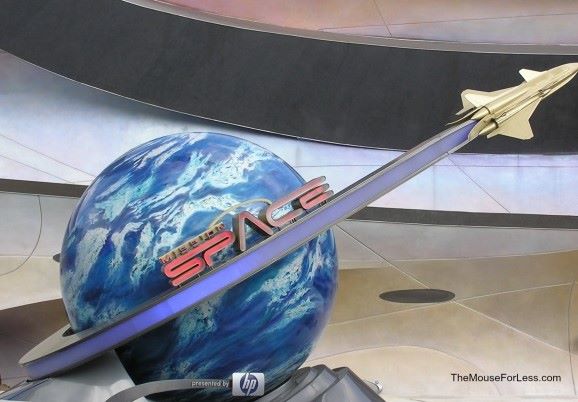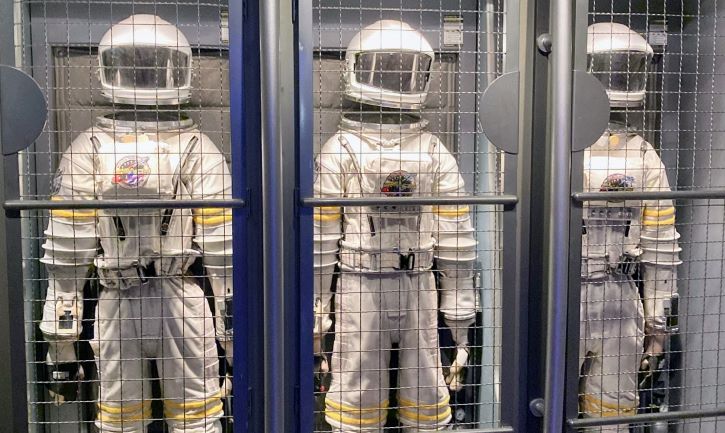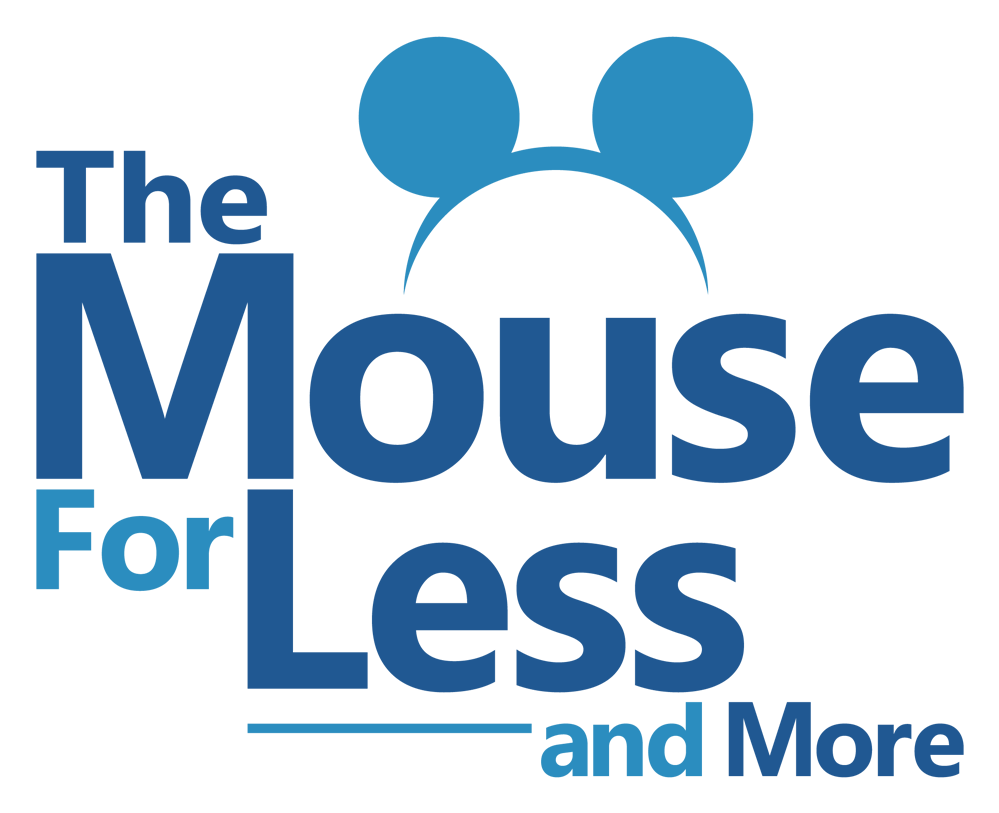
Blast off to Mars on the most ambitious simulator attraction ever created by Walt Disney Imagineering. With Mission: SPACE, there are two very different options to choose from. On the Orange Mission, which features more intense training, Guests are able to experience a truly intense experience and feel the forces of actual space launch. On this mission, you’ll dodge meteoroids, slingshot around the moon and attempt a precision landing on the Red Planet’s alien surface. The Orange version has been enhanced with new HD video.
If you don’t want to experience the intense version of the ride that you’ll find on the Orange Mission, the new Green Mission is family-friendly courtesy of the new X-2 booster seats. On the Green Mission, you’ll get to take an exciting orbit around Earth where you’ll see the Hawaiian Islands, the Northern Lights, and Italy all from space, before finally landing at Kennedy Space Center.
Mission: SPACE Ride Information
Opening Day: August 15, 2003
Type of Ride: Simulator
Age Recommendation: Older children and adults
Duration of Ride: About 5 minutes
Typical Queue Time: Moderate to long for the Orange (more intense) version; typically peaks at about 45 minutes. Short to moderate for the Green (less intense) version; typically peaks at about 20 minutes
Single Rider Line: No
Chicken Exit Available: Yes
Baby Swap Available: Yes
Type of Vehicle: Capsule
Type of Restraint: Harness
Attraction Open During Extended Evening Hours: No. See our Extended Evening Hours page for more information.
Ride Photo Available For Purchase: No

Mission: SPACE Ride Restrictions
Height Requirements: Green Mission – 40 inches / Orange Mission – 44 inches
Flash Photography or Video Allowed: No
Safety, Accessibility, and Guest Policies
Accessibility: Guests must transfer from Wheelchair/ECV, Handheld Captioning
Advisories: Service Animals not permitted
Guest Policies: Guests uncomfortable in dark enclosed spaces or simulators should not ride, children under 7 years must be accompanied by a person age 14 or older, seating and restraints may prohibit guests of certain body shapes or sizes from riding
- GREEN MISSION: Expectant mothers should not ride
- ORANGE MISSION: Expectant mothers should not ride. Guests should be in good health. Also, guests should be free of high blood pressure, back or neck problems, motion sickness, or other conditions that may be aggravated
Mission: SPACE Location
Shopping: With astronaut Mickey looking on, a plethora of space-themed merchandise is offered. For instance, merchandise includes apparel, plush dolls, helmets, Star Wars goods, and freeze-dried ice cream, can be purchased at Mission: SPACE’s gift shop, “Mission: SPACE Cargo Bay.” Also, Epcot’s premier gift shop, “Connections,” is also located nearby.
Restroom: Facilities convenient to Mission: SPACE are located on the path between the attraction and the Connections gift shop. Specifically, facilities are on the opposite side of the monorail loop.
Smoking Location: Smoking is permitted in designated smoking areas only. Disney parks are smoke free.
Mission: SPACE Fun Facts
Did you know?
- In the words of Frank Sinatra, have you ever wanted to “see what spring is like on Jupiter and Mars”? Well, Jupiter is beyond our reach, but on Mission: SPACE, guests train at the fictitious International Space Training Center (ISTC) for a mission to develop a colony on Mars. Furthermore, the mission is set in 2036. This is 75 years after Soviet pilot Yuri Gagarin became the first man in space.
- Mission: SPACE offers two “training” options: first the more intense “Orange Team” which takes Guests to Mars and next the less intense “Green Team” which takes Guests on a trip that showcases some of Earth’s beautiful majesty. August 13, 2017 launched the updated version. If members among your party select different teams, the party will split accordingly.
- Mission: SPACE features 40 four-person capsules and four centrifuges. Specifically, the Orange Team has two capsules and the Green Team has two capsules. As a result, there are 10 capsules apiece.
- Mission: SPACE Orange involves covert spinning and side-to-side movements, which produce the sensations of gravity and weightlessness. The spinning is covert. Unlike other Disney spinners, such as the Magic Kingdom’s Mad Tea Party, riders on Mission: SPACE are enclosed.
- Mission: SPACE Green is a traditional simulator, sans spinning; guests choosing this option will have the same visual experience but will not endure the sensations of intense g-forces or weightlessness.
- From 2003 to 2006, Mission: SPACE featured only the more intense (Orange) option. The Orange version proved inaccessible to too many guests. Imagineers added the Green version in 2006.
- Each simulation chamber holds four guests. Guests have assigned rules complete their mission. For example, these roles include Commander, Pilot, Navigator, and Engineer. Guests press buttons to perform these roles when indicated, but such conduct is optional and will not affect the experience either way. The chambers have video screens to depict what you would be experiencing at what point on a real rocket launch. You will witness the flight through the sky into outer space, a slingshot around the Moon, and a meteor shower. Finally, guests land on the surface of Mars.
- Mission: SPACE is situated in Planetary Plaza. Celestial bodies are pressed into the ground outside the building. The building proper is adorned with replicas of the Moon, Earth, Jupiter, and Mars. Additionally, curved facades represent flight and orbits. The model Moon features 29 markers, indicating the respective landing locations of all United States and USSR lunar missions conducted between 1959 and 1976. Also present are a series of inspirational quotes from astronomers, astronauts, and other influential individuals, such as Galileo, Carl Sagan, Kalpana Chawla, and John F. Kennedy.
- Mission: SPACE’s queue a simulation laboratory. For example, in this brilliantly-themed area, guests can view a training capsule; a replica space vehicle living quarters; a model spacecraft; a Lunar Roving Vehicle on loan from the Smithsonian Institution; a series of plagues commemorating key moments in the history of space travel. It highlights Yuri Gagarin becoming the first man in space on April 12, 1961. In addition, the trio of Bill Shepard, Yuri Gidzenko, and Sergei Krikalev launching Expedition 1 to the International Space Station on October 31, 2000 is featured. Imaginary space elements such as Expedition 205 launching the first family into space on September 1, 2030; and a command center are a part of the experience.
- Following experience, guests can experience post show activities. For example, there is a maze and a pair of interactive games. Additionally, there a station to create a virtual postcard at the “Advanced Training Lab.”
- Walt Disney Imagineering developed Mission: SPACE over a five-year period in conjunction with NASA advisors, astronauts, and scientists.
- Mission: SPACE was the second Walt Disney World attraction based around a mission to Mars,. The first attraction offered a theater-in-the round presentation. “Mission to Mars” was the name of this past attraction. It operated in the Magic Kingdom theater from 1975 to 1993.
- Video monitors show footage of an albatross. Mission to Mars also used the albatross. Additionally, the attraction’s predecessor, “Flight to the Moon,”featured the albatross.
- Mission: SPACE Green was EPCOT’s second traditional simulator after “Body Wars,” which operated in the former Wonders of Life Pavilion, now the Festival Center, from 1989 to 2006.
- Mission: SPACE replaced “Horizons.” It was a tame omnimover experience projecting realistic visions of humanity’s future, which operated in a different building on Mission: SPACE’s turf from 1983 to 1999. In the hub of the living quarters in Mission: SPACE’s queue a keen eye can spot Horizons’ logo..
Top 5 Tips for Mission: SPACE

- Those who suffer from motion sickness should avoid riding the attraction. Also, those with claustrophobia, or any other ailment mentioned as a warning should avoid the attraction. Specifically, the Orange version is arguably the most intense experience at Walt Disney World.
- Space buffs should check out Mission: SPACE’s queue and post show area for the details even if they do not ride the attraction proper.
- Eat a regular meal a couple of hours before riding the Orange version of Mission: SPACE. Also, keep a piece of mint or hard candy in your mouth while riding. This is because low blood sugar will increase the likelihood of nausea.
- Guests interested in space travel may want to consider an excursion to the Kennedy Space Center at Cape Canaveral, Florida. It is about an hour east of Walt Disney World, therefore, it’s an easy day trip.


